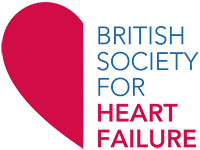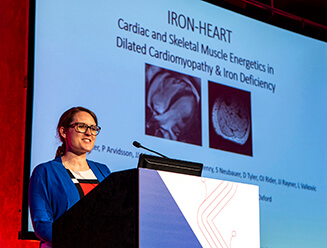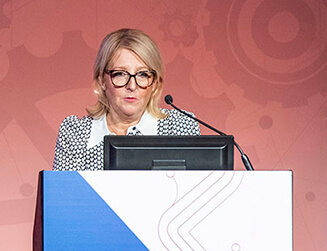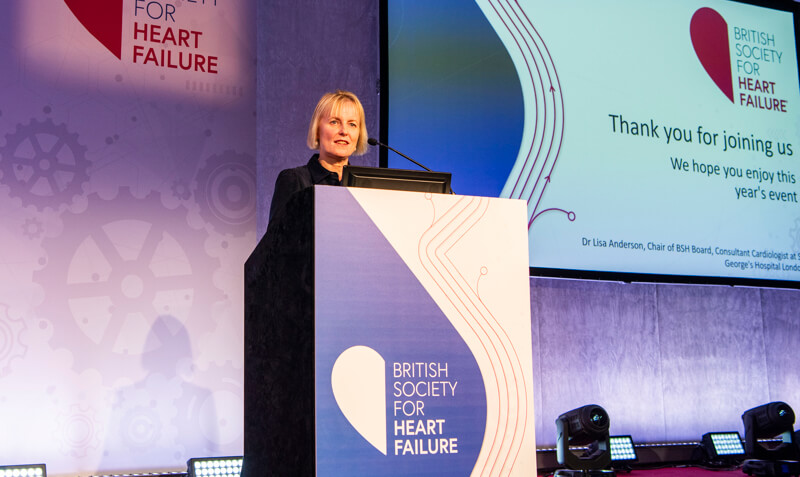The recent British Society for Heart Failure (BSH) 27th hybrid annual meeting highlighted the importance of building partnerships with collaborating societies and how this is vital to prioritising patient care and advancing the goal of 25in25, the BSH campaign to reduce heart failure mortality by 25% over the next 25 years. Held in London on 21st – 22nd November 2024, the meeting brought together over 700 members of heart failure teams from all nations to listen and learn from esteemed experts. Anna Briggs, Louise Collier, Edith Donnelly, Becky Hyland, Hayley Rose, and Teresa O’Nwere-Tan from the BSH Nurse Forum Author Board report the meeting highlights.
Early Investigator Award

The audience was treated to an impressive rapid-fire round with the three finalists for the Early Investigator Award, led by the judging panel; Dr Brian Halliday (Royal Brompton and Harefield Hospitals, London), Dr Rosita Zakeri (King’s College Hospital, London) and Rhys Williams (Cwm Taf Morgannwg University Health Board, Bridgend).
Clinical research fellow, Dr Sarah Birkhoelzer (Oxford University) presented her work on the IRON-HEART study, which aimed to determine the impact of iron repletion on cardiac and skeletal muscle energetics in patients with non-ischaemic cardiomyopathy with reduced ejection fraction. She showed that whilst there was no significant difference in phosphocreatine to ATP ratio post-iron administration, there were improvements in left ventricular ejection fraction (LVEF), reduction in left ventricular end systolic volume, improvements in skeletal muscle perfusion, increase in six-minute walk test distance and quality of life scores.
The next finalist, core medical trainee, Dr John Louca (Cambridge University) highlighted his work on the multi-centred ODDCAT Database exploring outcomes from Donation after Circulatory Determination of death (DCD) transplantation. Comparison was made between thoraco-abdominal Normothermic Regional Perfusion (taNRP) and Direct Procurement and Perfusion (DPP) methods, with the latter having increased costs associated per use. The ODDCAT database has 504 cases of DCD, 223 via taNRP and 281 by DPP. Results to date appear to show reduction in severe primary graft dysfunction, and lower rate of rejection in the taNRP group, which is also a cost-effective and simpler interventional option. Dr Louca concluded cost modelling and a planned prospective randomised trial will provide guidance to its use in the UK.

Physiotherapist, Ms Samantha Grozotis, (St George’s Hospital, London) presented her work developing a risk-stratification tool for predicting functional decline with the aim of targeting those at risk to improved patient outcomes. Analysis of six months’ worth of patient data highlighted key predictors of functional decline, including hospital acquired infections, insufficient therapy sessions and a baseline clinical frail score between 4 and 6. Interestingly, those patients on a cardiac ward had worse outcomes to those on outlier wards. Ms Grozotis reflected that additional data including those with acute kidney injury, low estimated glomerular filtration rates (eGFRs), weight, iron levels and nutritional scores would further enhance her data set. Once fully developed the aim is to use this in clinical practice.
The three candidates were applauded for their work, with special congratulations to Dr Birkhoelzer who won the trophy for 2025 along with the prize of £250.
BSH Research Fellowship updates
BSH Research Fellows presented on the current progress with their projects and one, Alice Brennan, was able to present her competed project. Table 1 shows the current projects being funded by the BSH.
Table 1. BSH Fellow update
| BSH Research Fellow | Project |
| Nicole Asemota | Markers of Transplantability in Ex-situ Perfused Hearts |
| Janine Beezer | Polypharmacy in Heart Failure: Investigating the Relationship between Treatment and Outcomes – The POTION study |
| Joanne Bilak | A Multi-Ethnic Multicentre Randomised Controlled trial of a low energy diet for improving functional status in Heart Failure with Preserved Ejection Fraction; the AMEND-Preserved Study |
| Alice Brennan | Biomarkers in patients with suspected HFpEF |
| Elton Luo | To Determine the Prevalence of Undetected Heart Failure in Patients taking Loop Diuretics |
| Matthew Sadler | The Role of Clonal Haematopoiesis in Ventricular Modelling After Myocardial Infarction |
| Evgenia Zhubrina | HF Reported Patient Outcomes and Lived Experience of Remote Monitoring with HeartLogicTM |
| Key: HF = heart failure; HFpEF = heart failure with preserved ejection fraction | |
Fellow of the BSH

In 2022, the BSH marked 25 years since it was founded by Professor Philip Poole-Wilson, with annual Fellow of the BSH awards to celebrate excellence and recognise an individual’s contribution to improving heart failure (HF) care. This year, the honour was awarded to Professor Mark Petrie, Professor of Cardiology at the University of Glasgow, a cardiologist at Glasgow Royal Infirmary, and the Chair of the BSH Research Committee. Professor Petrie holds leadership roles in many clinical trials and has published over 350 original publications, many in high impact factor journals such as New England Journal of Medicine, Lancet, JAMA, Circulation and JACC, and is a deputy editor at the European Journal of Heart Failure.
Clinical trials update
Professor John McMurray (Glasgow University) presented a comprehensive update on HF clinical trials. His take home messages were that while not much has changed for the management of HF with reduced ejection fraction (HFrEF), there is more data on the use of sodium-glucose cotransporter-2 (SGLT2) inhibitors, finerenone and glucagon-like peptide-1 (GLP-1) receptor agonists in HF with mildly reduced ejection fraction (HFmrEF) and HFpEF. Professor John Cleland (University of Glasgow) also updated the audience on the BSH Investigator Research Network.
The details of trials discussed in both presentations are illustrated in table 2.
Table 2. Clinical trial update
| Completed trials | Summary |
| IRONMAN1 | Treatment with ferric derisomaltose led to a reduced risk of the primary outcome, recurrent hospital admissions for HF and cardiovascular death, providing further evidence of the benefits of correcting iron deficiency in this population |
| REVIVED2 | Among patients with severe ischaemic left ventricular systolic dysfunction who received optimal medical therapy, revascularisation by PCI did not result in a lower incidence of death from any cause or hospitalisation for heart failure |
| FINEARTS-HF3 | Primary composite endpoint of cardiovascular death and heart failure events showed significant benefit associated with treatment with finerenone; the benefit driven predominantly by HF events |
| STEP-HFpEF4 | Among patients with obesity-related HFpEF and type 2 diabetes, semaglutide led to larger reductions in HF-related symptoms and physical limitations and greater weight loss than placebo at one year |
| SUMMIT5 | Treatment with tirzepatide led to a lower risk of a composite of death from cardiovascular causes or worsening HF than placebo and improved health status in patients with HFpEF and obesity |
| Recruiting trials | |
| UK HFpEF6 | Aims to improve understanding of why people develop HFpEF; to develop better tests to diagnose this condition; and to test new treatments |
| REACH-HFpEF | Investigating the cost-effectiveness of home-based cardiac rehabilitation in HFpEF |
| Subcut 2 Trial | Multicentre open-label RCT for patients hospitalised for HF who would usually be treated with IV furosemide in hospital |
| PROTECT-HF | Physiological vs. Right ventricular pacing OUtcome Trial Evaluated for bradyCardia Treatment |
| BRITISH DCM7 | Using cardiovascular magnetic resolution imaging as the benchmark risk indication tool for implantable cardioverter defibrillators in patients with non- ischaemic cardiomyopathy severe systolic HF |
| BalanceD-HF | Balcinerenone plus dapagliflozin in patients with heart failure across the LVEF ranges and CKD |
| Easi-HF | Vicadrostat plus empagliflozin vs. empagliflozin in HFmrEF/HFpEF |
| Key: CKD = chronic kidney disease; HF = heart failure; HFpEF = heart failure with preserved ejection fraction; IV = intravenous; LVEF = left ventricular ejection fraction; PCI = percutaneous coronary intervention; RCT = randomised clinical trial |
|
Abstracts
A plethora of abstracts highlighting studies and quality improvement projects for good clinical practice were submitted and judged by members from the BSH Research Committee, with 43 submissions invited to display posters during the meeting. The top six scoring posters were presented orally on the first day of the conference (table 3).
Table 3. Top six posters
| Name | Institution | Summary |
| Dr Aaron Henry Winner |
University of Oxford and Jersey General Hospital | Evaluating survival outcomes across NT-proBNP levels. An island-wide retrospective study |
| Elton Luo | Hull University Teaching Hospitals NHS Trust | Loop diuretics, heart failure diagnosis, and outcome in primary care |
| Minimol Santhosh | Central London Community Healthcare NHS Trust – Harrow | Hair, nails and supermarkets: a High Street approach to reducing health inequalities through hypertension case finding |
| Pooja Dewan | Milton Keynes University Hospital | Screening and treatment of iron deficiency in a district general hospital |
| Dr Maria Antionetta Riemma | Department of Experimental Medicine, University of Campania L Vanvitelli, Naples, Italy | Effects of sacubitril valsartan alone or in combination with dapagliflozin on ageing-related heart failure with preserved ejection fraction |
| Johnathan Lazari | East Sussex Healthcare | Initiation and continuation of heart failure treatments in an elderly population: a single-unit retrospective analysis |
Congratulations goes to Dr Aaron Henry, NIHR Academic Clinical Fellow (University of Oxford) and Honorary Research Fellow (Jersey General Hospital), the winner of this year’s poster competition. His project aimed to evaluate mortality rates across different N-terminal pro B-type natriuretic peptide (NT-proBNP) levels and to determine the impact of cardiology involvement within three months of the index NT-proBNP test on patient survival. Some 11,347 patient records were analysed with data showing higher NTproBNP levels were strongly associated with increased mortality, but that early cardiology consultation following elevated NT-proBNP was linked to improved survival.
Lynda Blue Award

Lynda Blue was a pioneer in HF who transformed its care. Through her passion and hard work, she laid the foundations to all future heart failure nurses around the world. After her sudden death in 2018, the Lynda Blue award was created to honour her work by recognising an individual or team of professionals who have demonstrated excellence in HF care.
Open to nominations of all HF nurses and allied healthcare professionals, this year there were nine strong nominees who were acknowledged on stage at the conference (table 4). The winner of the 2024 award was HF nurse consultant Mrs Carys Barton (Imperial College Healthcare NHS Trust). She is highly regarded for her inspiring leadership and visionary developments for both HF patients and professionals working across the specialty. She was the first nurse to be appointed Deputy Chair at the BSH and is now Chair Elect. Her passion of care for patients living with HF is clearly seen through her work locally and nationally. She was involved in developing HF nurse competencies, a document now used across the country to help develop HF specialist nurses. She is a leader, mentor and inspiration to many who work in HF and a truly worthy winner of the Lynda Blue award.
Table 4. Nominees for the 2024 Lynda Blue Award
| Winner: Carys Barton, HF nurse consultant, Imperial College Healthcare NHS Trust |
| Angela Murphy and Morna Johnston, HF specialist nurses, Chelsea and Westminster Hospital NHS Foundation Trust |
| Angela Tithecott, Lead HF specialist nurse, Royal Devon University Healthcare NHS Foundation Trust |
| Carol Patton, HF specialist nurse, Southern Health and Social Care Trust, County Armagh |
| Diana Astbury, Lead Advanced HF nurse, Cheshire and Wirral Partnership NHS Foundation Trust |
| Georgina O’Regan and Natasha Marshall, HF Specialist Nurses, Birmingham Community Healthcare Trust |
| Linda Edmunds, HF/Cardiac Rehabilitation Nurse Consultant, County Hospital, Pontypool |
| Paul Forsyth, HF Pharmacist, NHS Greater Glasgow and Clyde |
| The HF team, George Eliot Hospital, Nuneaton |
| Key: HF = heart failure |
The great debates
What is more important – the kidneys or the heart? This was the motion for a superbly entertaining debate run jointly with the Cardiorenal Forum. Dr Patricia Campbell (Southern Trust Health and Social Care Trust, Northern Ireland and BSH Treasurer) and Dr Henry Purcell (Editor, British Journal of Cardiology), chaired a sparring Nephrologist Professor Philip Kalra (Salford Royal Hospital) and Cardiologist Professor Paul Kalra (Portsmouth Hospitals NHS Trust) who had compelling cases for both organs. Despite the levity in both presentations, the debate illustrated the importance of joint working in the cardiorenal space, with cohesive working between HF and nephrology teams essential for clinical excellence in patient care and in improving patient outcomes.
The final session of the conference delivered a lively debate on imaging techniques for patients. The session, run jointly with the British Society for Echocardiography (BSEcho), was chaired by Shaun Robinson (Imperial College NHS Trust and Vice-President of BSEcho) and Laurence Humphrey Davis (BSH Chair – Patient Advisory Panel). The speakers were each given a question to debate.
- Does everyone only need an echo? Professor Andrew Clark (Castle Hill Hospital, Hull)
- Does everyone need an angiogram? Professor Divaka Perera (Guys and St Thomas’ Hospital, London)
- Does everyone need a cardiac MRI (CMR)? Dr John Baksi (Royal Brompton Hosptial, London).
Professor Andrew Clarke commenced his argument that when diagnosing and managing HF, an echo is the only investigation needed. It is relatively inexpensive and can be done at the bedside, giving the key information needed, the all-important LVEF – important because this is what determines which patients will benefit from HF treatment and care and those who will not.
Next to the podium was Professor Divaka Perera, who contended that the echo only approach fails to recognise the importance of aetiology in the management of HF. He explained that angiography – either invasive or non-invasive – is needed to distinguish between ischaemic and non-ischaemic aetiologies. While this information might not change medical therapy with the four pillars, it might help to stratify who would benefit from revascularisation and/or a device such as an implantable cardioverter defibrillator (ICD).
Finally, Dr John Baksi (spoke in defence of CMR imaging. He explained that CMR is the gold standard approach to assessing cardiac size and function, and it can also assess morphology, function, perfusion, viability, and discriminate between subtle phenotypes with accuracy, all of which are needed to determine aetiology and inform treatment decisions.
All three experts set out a robust case for their positions and left the audience to weigh up the answers given to the three clinical conundrums based on the evidence provided.
Permissive cardiotoxicity
Anthracycline-induced HF is a recognised complication of cancer treatment-related cardiac dysfunction (CTRCD). It ranges from asymptomatic myocardial injury to overt HF, categorised into stages A to D. Dr Charlotte Manisty (University College London) gave a presentation on ‘Permissive cardiotoxicity – how low should we go?’. Since anthracyclines, critical in cancer care, are cardiotoxic, it necessitates strategies to balance cancer efficacy with cardiac safety. Permissive cardiotoxicity – tolerating mild-to-moderate CTRCD during HER2-targeted therapies – has shown promise in trials like SAFE-HEaRt and HER2+ CTRCD studies, emphasising the importance of stratifying therapy and individualising HF management.
The four pillars of HF management – renin-angiotensin system inhibitors, beta blockers, mineralocorticoid receptor antagonists, and SGLT2 inhibitors – remain foundational. Recent evidence suggests gradual escalation of HF therapy may improve outcomes in CTRCD,8 challenging the early de-escalation paradigm. Crucially, cardiotoxic chemotherapy should be paused only when necessary, as interruptions can worsen cancer and cardiac prognoses. Multidisciplinary team (MDT) involvement is essential, integrating cardiology, oncology, and supportive care to optimise outcomes.
Amyloidosis
Deputy Chair of BSH, Dr Carol Whelan (Royal Free Hospital, London) has a special interest in cardiac amyloidosis. She presented an amyloidosis overview and guidance explaining that the condition is often seen in transthyretin (TTR) or light chain (AL) forms and is increasingly diagnosed using advanced imaging such as CMR and DPD scintigraphy. While TTR wild-type predominates in elderly men, hereditary forms involve neuropathic or cardiopathic presentations. Diagnosis is nuanced, with echocardiography and longitudinal strain complementing imaging, though negative DPD does not exclude the disease. Daratumumab is licensed for AL amyloidosis, often guided by myeloma protocols.
The ESC9 emphasises MDT care, periodic troponin monitoring, and balancing cancer efficacy against cardiotoxicity risk. NICE guidance aligns with this, endorsing therapies like daratumumab while integrating evolving evidence for permissive cardiotoxicity and HF management.
Ongoing trials, including Henriksen et al.10 continue to refine the role of cardio-oncology in achieving optimal patient outcomes.

Anna Briggs, Louise Collier, Edith Donnelly, Becky Hyland, Hayley Rose, and Teresa O’Nwere-Tan
BSH Nurse Forum Author Board
BSH 2025 diary dates
- 1st – 2nd May: BSH Multi-Disciplinary Training Meeting, Cardiff
- 20th – 21st November: BSH Annual Meeting, London
Conflicts of interest
None declared.
Funding
None.
References
1. Kalra P, Cleland JGF, Petrie MC et al. Intravenous ferric derisomaltose in patients with heart failure and iron deficiency in the UK (IRONMAN): an investigator-initiated, prospective, randomised, open-label, blinded-endpoint trial. Lancet 2022;400:2199–2209. https://doi.org/10.1016/S0140-6736(22)02083-9
2. Perera D, Clayton T, O’Kane PD, et al. Percutaneous revascularisation for ischaemic left ventricular dysfunction. N Engl J Med 2022;387:1351–60. https://doi.org/10.1056/NEJMoa2206606
3. Solomon SD, McMurray JJV, Vaduganathan M et al. Finerenone in heart failure with mildy reduced or preserved ejection fraction. N Engl J Med 2024;381:1475–85. https://doi.org/10.1056/NEJMoa2407107
4. Kosiborod M, Petrie MC, Borlaug BA, et al. Semaglutide in patients with obesity-related heart failure and type 2 diabetes. STEP-HFpEF Trial. N Engl J Med 2024;390:1394–407. https://doi.org/10.1056/NEJMoa2313917
5. Packer M, Zile MR, Kramer CM, et al. Tirzepatide in heart failure with preserved ejection fraction and obesity. N Engl J Med 2024 (published online 16th November 2024). https://doi.org/10.1056/NEJMoa2410027
6. Miller C, Al-Mohammad M, Beezer J, et al. UK HFpEF Collaborative Group. Rationale and design of the United Kingdom Heart Failure with Preserved Ejection Fraction Registry. Heart 2024;110:359–65. https://doi.org/10.1136/heartjnl-2023-323049
7. Flett A, Cebula A, Nicholas Z, et al. Rationale and study protocol for the BRITISH randomized trial (Using cardiovascular magnetic resonance identified scar as the benchmark risk indication tool for implantable cardioverter defibrillators in patients with nonischemic cardiomyopathy and severe systolic heart failure). Am Heart J 2023;266:149–58. https://doi.org/10.1016/j.ahj.2023.09.008
8. Cho I, You SC, Cha MJ, et al. Cancer therapy-related cardiac dysfunction and the role of cardiovascular imaging: systemic review and opinion paper from the Working Group on Cardio-Oncology of the Korean Society of Cardiology. J of Cardiovasc Imaging. 2024;32:13. https://jcvi.biomedcentral.com/articles/10.1186/s44348-024-00014-5
9. Lyon AR, López-Fernández T, Couch LS, et al. ESC Guidelines on cardio-oncology developed in collaboration with the European Hematology Association (EHA), the European Society for Therapeutic Radiology and Oncology (ESTRO) and the International Cardio-Oncology Society (IC-OS): Developed by the task force on cardio-oncology of the European Society of Cardiology (ESC). Eur Heart J 2022;43:4229–361. https://doi.org/10.1093/eurheartj/ehac244
10. Henriksen P et al. (2023) Multicenter, prospective, randomized controlled trial of high-sensitivity cardiac troponin I–guided combination angiotensin receptor blockade and beta-blocker therapy to prevent anthracycline cardiotoxicity: The Cardiac CARE Trial. Circulation 2023;148:1680–90. https://doi.org/10.1161/CIRCULATIONAHA.123.064274
